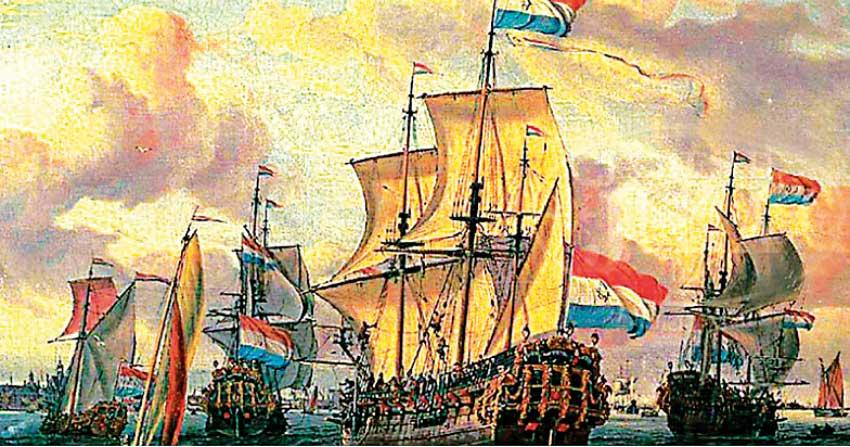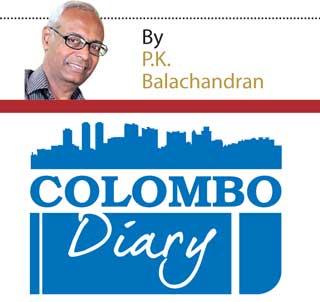24 Sep 2022 - {{hitsCtrl.values.hits}}

 The Dutch were a pre-eminent politico-economic and military power in Ceylon and South India in the 17th and 18th centuries, having driven out the Portuguese from the region’s lucrative spice trade. But the Dutch could not withstand the onslaught of the British and the French when the latter made their appearance in the latter part of the 18th century. By 1796-1798, Dutch power had collapsed in both Ceylon and South India. In 1796, the Dutch surrendered their possessions in Ceylon virtually without a fight.
The Dutch were a pre-eminent politico-economic and military power in Ceylon and South India in the 17th and 18th centuries, having driven out the Portuguese from the region’s lucrative spice trade. But the Dutch could not withstand the onslaught of the British and the French when the latter made their appearance in the latter part of the 18th century. By 1796-1798, Dutch power had collapsed in both Ceylon and South India. In 1796, the Dutch surrendered their possessions in Ceylon virtually without a fight.
There could have been more reasons than one for the collapse of the Dutch East India Company (Vereenigde Oostindische Compagnie or VOC). Some say that the VOC was not as good a business organisation as the English East Indian Company (EIC) was and that it was essentially a military organisation extracting wealth from areas across the world by the use of brute force. But Erik Odegard of Erasmus University in Rotterdam in his paper entitled: In Search of Sepoys: Indian soldiers and the Dutch East India Company in India and Sri Lanka, 1760–1795 (War in History 2022, Vol. 29(3) 543–562) places the blame at the door of the VOC’s military structure and the ideas behind that structure which were unsuited to conditions in South Asia.
The Dutch military structure varied radically from those of the military under the EIC and the French East Indian Company (Compagnie française pour le commerce des Indes Orientales). While the British and French companies were successful, the VOC had difficulty facing the military of the British and the French through much of the 18th century. The VOC was finally forced to fold up by the close of the 18th century.
Some say that the VOC was not as good a business organisation as the English East Indian Company (EIC) was and that it was essentially a military organisation extracting wealth from areas across the world by the use of brute force
Too Many Europeans, Too Few Local Troops
Unlike the French and the British India East Indian Companies, the VOC did not recruit local soldiers (or Sepoys) in sufficient numbers, but relied heavily on White troops brought down from Holland and Germany at frequent intervals and at great cost. In December 1777, for example, the VOC’s garrisons in Ceylon had 3,252 men, of whom 2,422 were European infantry and artillerymen. The remainder was made up of 686 Oosterlingen (‘Easterners’, or ‘Malays’ from Java) and 142 ‘free Moors’. European troops made nearly 75% of the Dutch military labour force in Ceylon.
In contrast, when Robert Clive went to Bengal for conquest in 1757, he took with him an army of some 800 European infantry and 1,200 sepoys. By 1763, the East India Company (EIC) was maintaining a standing army of 18,230 soldiers in India composed of a few Europeans and a vast body of locally recruited troops. Two decades later, the EIC army in Bengal alone amounted to some 34,000 men organised in 1,000 men battalions. By the mid-1790s, the EIC had an army of some 73,000 men in India. The vast majority of these soldiers were Indian Sepoys.
Erik Odegard notes that “The effectiveness of these (local) soldiers and their units in this army had improved over time as well, to the point where British officers were worried they might be training these troops to eventually defeat the EIC itself!”
The British and the French had found out quite early in their adventures in India that local recruits could turn out to be excellent soldiers if properly trained by European officers and led by them. These men could easily rout large native armies even if the weaponry used was of the same quality. Therefore, the British and French had a small body of Europeans who were in the lead but the bulk of the fighting was done (and done well) by the local and other Asiatic troops.
The non-European recruits in Ceylon were Sinhalese, Tamils and Muslims, South Indians brought from India, and Catholics from Ceylon and Malabar. In the case of the Dutch, there were Malays brought from Java. All European armies in Ceylon (and also South India) recruited more or less from the same pool of military labour. Only the numbers varied, with the British using locals much more than the Dutch.
Advantages of Recruiting Locals
Local troops had great advantages over the Europeans. They were acclimatised and hardier too. Europeans might be more daring, but they tended to have little resistance to tropical diseases. The death rate among them was high. The British and the French saved money by recruiting locally. Locals and other Asians were paid less. If the locals had their lands nearby, they could be asked to fend for themselves as was noted in the British campaigns in the Kandyan hills. Relying heavily on a large European contingent, the Dutch were spending a lot on salaries. And a lot of money was also being spent on shipping troops from Europe.
Absence of Standing Army
The Dutch recruitment of locals was on an ad hoc basis for particular campaigns. The ad hoc recruits were hastily trained and were discharged when the campaign was over. The European officers and the Indian (or Ceylonese) men had little time to develop an understanding of each other, and develop an esprit de corps necessary when fighting together under trying circumstances.
But in the British East India Company (EIC) the locals were kept in service even during peacetime. This not only enabled training over a longer period of time but also the fostering of comradeship and a sense of commitment to one’s unit. The Indian units in EIC showed what German sociologist Max Weber called “Organic solidarity” while the Indian units in the Dutch army were like a sack of potatoes which could fall apart at the slightest disturbance.
Being standing armies, the local recruits of the British and French East India companies had a regular pay structure apart from security of employment. Security of employment and a regular pay structure made the Indian recruit willingly agree to serve overseas in any part of the British empire. The Dutch too moved troops from one part of the VOC world to another. But they found it difficult to get local soldiers volunteering for service overseas. The Dutch, therefore, tended to rely heavily on European troops and the Topasses (Eurasians) who identified themselves with Europeans.
VOC reports are replete with complaints about the quality and behaviour of their local recruits in both Ceylon and India. There were accusations of indiscipline and cowardice in the face of the enemy in Malabar in the 1770s and Negapatnam in 1781. But the fault was in the recruitment, pay and retention policies, Erik Odegard argues.
Accommodation of Local Norms
Besides the recruitment policy and the force structure, there was another flawed aspect that needs to be mentioned. John Lynn has pointed out that the EIC was successful in integrating Sepoys into its armies because it took into account Hindu caste rules and taboos.
“Lynn argues that to foster existing concepts of Jati (caste), duty, honour, and loyalty in its troops, the Company had a stake in allowing the Sepoy to remain integrated into his original community as much as the demands of military service allowed”. By allowing soldiers to remain in touch with, and be part of, their home community, the EIC effectively made sure that its troops would fight well to maintain their honour.
On the contrary, the Dutch were insensitive to this sociological aspect. Regiments gelled together because caste dietary preferences and taboos were respected and maintained. To date, the Indian army, heir to the army of the EIC, is organised into regiments mostly based on caste, religion, region and language, though there are mixed regiments also.
BLURBS
1
2
While the British and French companies were successful, the VOC had difficulty facing the military of the British and the French through much of the 18th century
3
The British and the French had found out quite early in their adventures in India that local recruits could turn out to be excellent soldiers if properly trained by European officers and led by them
4
Local troops had great advantages over the Europeans. They were acclimatised and hardier too. Europeans might be more daring, but they tended to have little resistance to tropical diseases
5
By allowing soldiers to remain in touch with, and be part of, their home community, the EIC effectively made sure that its troops would fight well to maintain their honour
04 Jan 2025 9 hours ago
04 Jan 2025 9 hours ago
04 Jan 2025 9 hours ago
04 Jan 2025 04 Jan 2025
04 Jan 2025 04 Jan 2025